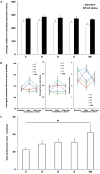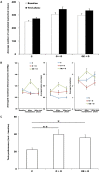The combination of perception of other individuals and exogenous manipulation of arousal enhances social facilitation as an aftereffect: re-examination of Zajonc's drive theory
- PMID: 25999906
- PMCID: PMC4423469
- DOI: 10.3389/fpsyg.2015.00601
The combination of perception of other individuals and exogenous manipulation of arousal enhances social facilitation as an aftereffect: re-examination of Zajonc's drive theory
Abstract
Zajonc's drive theory postulates that arousal enhanced through the perception of the presence of other individuals plays a crucial role in social facilitation (Zajonc, 1965). Here, we conducted two experiments to examine whether the elevation of arousal through a stepping exercise performed in front of others as an exogenous factor causes social facilitation of a cognitive task in a condition where the presence of others does not elevate the arousal level. In the main experiment, as an "aftereffect of social stimulus," we manipulated the presence or absence of others and arousal enhancement before participants conducted the primary cognitive task. The results showed that the strongest social facilitation was induced by the combination of the perception of others and arousal enhancement. In a supplementary experiment, we manipulated these factors by adding the presence of another person during the task. The results showed that the effect of the presence of the other during the primary task is enough on its own to produce facilitation of task performance regardless of the arousal enhancement as an aftereffect of social stimulus. Our study therefore extends the framework of Zajonc's drive theory in that the combination of the perception of others and enhanced arousal as an "aftereffect" was found to induce social facilitation especially when participants did not experience the presence of others while conducting the primary task.
Keywords: arousal; drive theory; observation; social facilitation; social perception.
Figures




Similar articles
-
Social facilitation as a function of the mere presence of others.J Soc Psychol. 2001 Apr;141(2):190-7. doi: 10.1080/00224540109600546. J Soc Psychol. 2001. PMID: 11372565
-
Social facilitation during the initial stage of motor learning: a re-examination of Martens' audience study.J Mot Behav. 1978 Dec;10(4):325-37. doi: 10.1080/00222895.1978.10735166. J Mot Behav. 1978. PMID: 15186994
-
Dissociation of the neural substrates of foraging effort and its social facilitation in the domestic chick.Behav Brain Res. 2015 Nov 1;294:162-76. doi: 10.1016/j.bbr.2015.07.052. Epub 2015 Jul 30. Behav Brain Res. 2015. PMID: 26235329
-
Social facilitation: a meta-analysis of 241 studies.Psychol Bull. 1983 Sep;94(2):265-92. Psychol Bull. 1983. PMID: 6356198 Review. No abstract available.
-
The effect of exercise-induced arousal on cognitive task performance: a meta-regression analysis.Brain Res. 2010 Jun 23;1341:12-24. doi: 10.1016/j.brainres.2010.03.091. Epub 2010 Apr 8. Brain Res. 2010. PMID: 20381468 Review.
Cited by
-
Impairments of social interaction in a valproic acid model in mice.Front Behav Neurosci. 2024 Aug 29;18:1430267. doi: 10.3389/fnbeh.2024.1430267. eCollection 2024. Front Behav Neurosci. 2024. PMID: 39267983 Free PMC article.
References
-
- Aiello J. R., Douthitt E. A. (2001). Social facilitation from Triplett to electronic performance monitoring. Group Dyn. 5, 163–180 10.1037/1089-2699.5.3.163 - DOI
-
- Aiello J. R., Svec C. M. (1993). Computer montoring of work performance: extending the social facilitation framework to electronic presence. J. Appl. Soc. Psychol. 23, 537–548 10.1111/j.1559-1816.1993.tb01102.x - DOI
-
- Allport F. H. (1920). The influence of the group upon association and thought. J. Exp. Psychol. 3, 159–182 10.1037/h0067891 - DOI
-
- Allport F. H. (1924). Social Psychology. New York, NY: Houghton Mifflin Company.
LinkOut - more resources
Full Text Sources
Other Literature Sources

